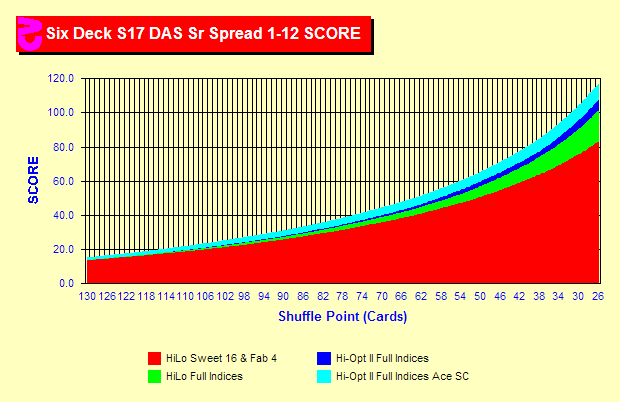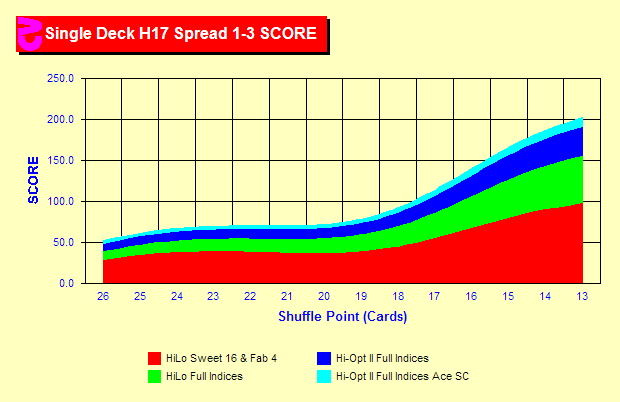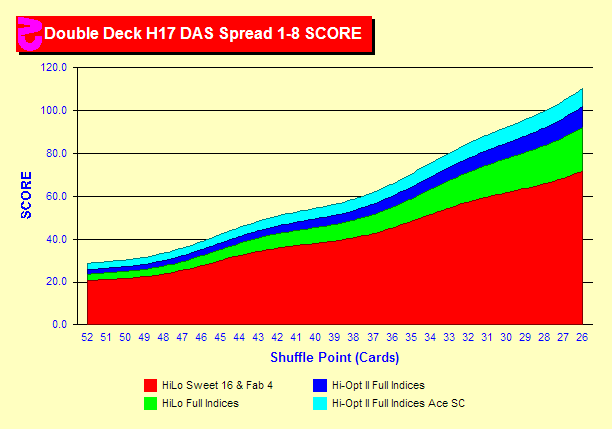|
|
Ace-Neutral/Ace-Reckoned
 What
about Ace-Neutral strategies and Ace side counts? What
about Ace-Neutral strategies and Ace side counts?
Some strategies count the ace as zero (ace-neutral) and some count
the ace as negative (ace-reckoned). The ace is unusual as it is
both a high card and a low card. When we look at playing efficiency,
the ace is low because it does not bust hands. When we look at betting
efficiency, the ace is high primarily because it is needed for a
Blackjack. So we have to decide if we want to count it. Generally,
ace-reckoned strategies (e.g. Hi-Lo, KO, Revere PC) are better suited
to shoes, because betting is more important in shoe games, and ace-neutral
strategies (e.g. Hi-Opt I, AO II) are better suited to single-deck,
since playing is more important in pitch games. For those that do
not wish to compromise, you can use an ace-neutral strategy, keep
a side count of aces and count them for betting purposes but not
for playing purposes. This is the ideal in efficiency — but
substantially more difficult. Is it worth it?
In this chart we see a shoe game with Hi-Lo, a level I strategy,
in red using only 20 indexes. Green displays the gain from using
full indexes. The blue area is the gain switching to Hi-Opt II,
an ace-neutral strategy not normally advised for shoes. Some people
believe that ace-neutral strategies are no good for shoes. As we
can see, Hi-Opt II works quite well. But the gain over a level I
strategy is minimal. In fact almost no gain is realized at normal
penetrations. Now let's add an ace side count. The cyan area shows
a further increase due solely to the side count. The blue and cyan
areas together are the gain from moving to a level II, ace-neutral
strategy with a side count.
|
 What
about single-deck? What
about single-deck?
Let us look at the same strategies in a single-deck game. Here
we see much larger differences. But, the ace side count adds little
in this case because betting is less important in single-deck. Most
of the gain in using Hi-Opt II can be realized without bothering
with the side count.
Whether one goes through this extra effort is a personal choice.
In the past, complex strategies were very popular. Most players
these days choose less complex strategies.
|
|
 What
about double-deck? What
about double-deck?
Since double-deck is the new single-deck, I've provided a two-deck
chart.
|
|
Sim details
- Six decks, S17, DAS, LS, 4 players, Hi-Lo, truncate, Sweet 16
& Fab 4 indexes, half-deck resolution, penetrations from 26-130
cards cutoff by the card
- Six decks, S17, DAS, LS, 4 players, Hi-Lo, truncate, max indexes,
half-deck resolution, penetrations from 26-130 cards cutoff by
the card
- Six decks, S17, DAS, LS, 4 players, HiOpt II, truncate, max
indexes, half-deck resolution, penetrations from 26-130 cards
cutoff by the card
- Six decks, S17, DAS, LS, 4 players, HiOpt II Ace SC, truncate,
max indexes, half-deck resolution, penetrations from 26-130 cards
cutoff by the card
- Single-deck, H17, 3 players, Hi-Lo, truncate, Sweet 16 &
Fab 4 indexes, quarter-deck resolution, penetrations from 13-26
cards cutoff by the card
- Single-deck, H17, 3 players, Hi-Lo, truncate, max indexes, quarter-deck
resolution, penetrations from 13-26 cards cutoff by the card
- Single-deck, H17, 3 players, HiOpt II, truncate, max indexes,
quarter-deck resolution, penetrations from 13-26 cards cutoff
by the card
- Single-deck, H17, 3 players, HiOpt II Ace SC, truncate, quarter
indexes, half-deck resolution, penetrations from 13-26 cards cutoff
by the card
- Double-deck, H17, DAS, 3 players, Hi-Lo, truncate, Sweet 16 &
Fab 4 indexes, quarter-deck resolution, penetrations from 26-52
cards cutoff by the card
- Double-deck, H17, DAS, 3 players, Hi-Lo, truncate, max indexes,
quarter-deck resolution, penetrations from 26-52 cards cutoff
by the card
- Double-deck, H17, DAS, 3 players, HiOpt II, truncate, max indexes,
quarter-deck resolution, penetrations from 26-52 cards cutoff
by the card
- Double-deck, H17, DAS, 3 players, HiOpt II Ace SC, truncate,
quarter indexes, quarter-deck resolution, penetrations from 26-52
cards cutoff by the card
- Two billion rounds each, all sims use optimal betting, full
Kelly
|
|
|
 What
about Ace-Neutral strategies and Ace side counts?
What
about Ace-Neutral strategies and Ace side counts? What
about single-deck?
What
about single-deck? What
about double-deck?
What
about double-deck?